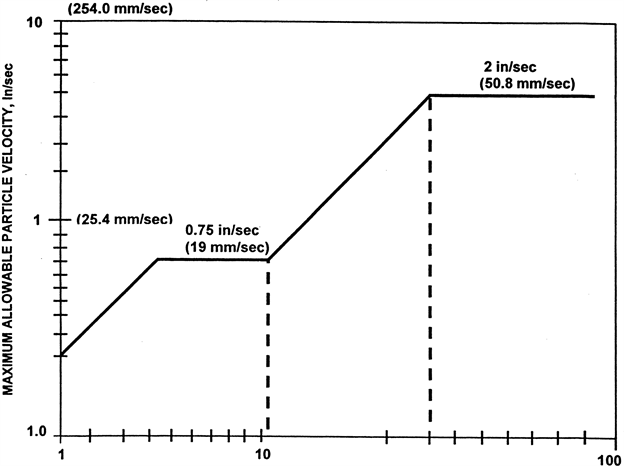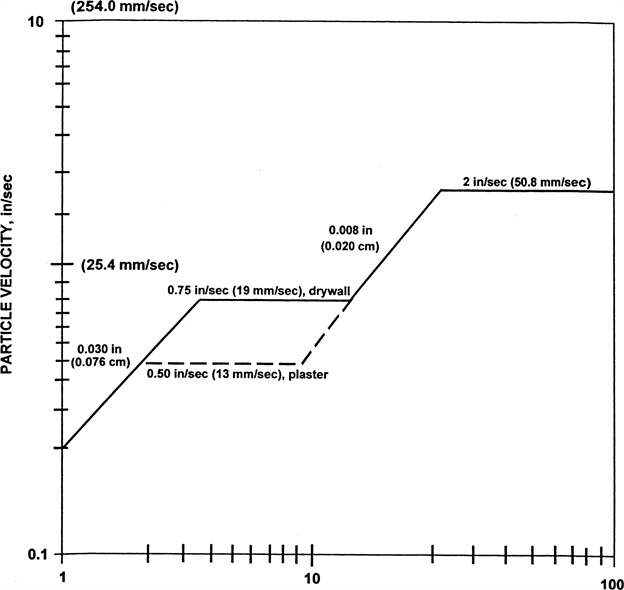(1) Ground vibration - maximum limits.
Either Table 8-A or Table 8-B can be used to determine the maximum limits of ground vibration for any dwelling, public building, school church, commercial site, cofferdams, piers, underwater structures, or institutional building nearby the blasting site. The methods used for monitoring vibration and calculating frequency must be included in the blast plan.
Table 8-A peak particle velocity limits | |
Distance from blasting site | Maximum allowable peak particle velocity1 |
0 to 300 ft (91.4 m) | 1.25 in/sec (31.75 mm/sec) |
301 to 5000 ft (91.5 m to 1524 m) | 1.00 in/sec (25.4 mm/sec) |
5001 ft (1525 m) and beyond | 0.75 in/sec (19 mm/sec) |
| 1 | Peak particle velocity must be measured in three mutually perpendicular directions and the maximum allowable limits must apply to each of these measurements. |
(a) Frequency versus particle velocity graphics. In lieu of Table 8-A, a blasting operation has the option to use the graphs shown in Figure 8a or 8b to limit peak particle velocity based upon the frequency of the blast vibration. If either of the graphs in Figure 8a or 8b is used to limit vibration levels, the methods used for monitoring vibration and calculating frequency must be included in the blast plan.
Figure 8a
Alternative Blasting Level Criteria
 |
blast vibration frequency, hz |
Figure 8b
Alternative Blasting Level Criteria
 |
blast vibration frequency, hz |
(b) Scaled distance equations. Unless a blasting operation uses a seismograph to monitor a blast to assure compliance with Table 8-A or Figures 9a or 8b, the operation must comply with the scaled distance equations shown in Table 8-B.
Table 8-B
SCALED-DISTANCE EQUATIONS
Distance from Blasting Site | Scaled Distance Equation |
0 to 300 ft (91.4 m) | W (lbs) = (d (ft)/50)2 or W (kg) = (d (m)/22.6)2 |
301 to 5000 ft (92 m to 1524 m) | W (lbs) = (d (ft)/55)2 or W (kg) = (d (m)/24.9)2 |
5001 ft (1524 m) and beyond | W (lbs) = (d (ft)/65) or W (kg) = (d (m)/29.4)2 |
Key: |
W = The maximum weight of explosives in pounds (or kilograms) that can be detonated per delay interval of 8 milliseconds or greater. |
d = The distance in feet (or meters) from the blast to the nearest dwelling, public building, school, church, commercial, or institutional building not owned, leased, or contracted by the blasting operation, or on property where the owner has not given a written waiver to the blasting operation. |
Note: | To convert English Units of scaled distances (ft/lb2) to metric units (m/kg2) divide by a factor of 2.21. |
(2) Air blast - Maximum limits. Air blast must not exceed the maximum limits listed in Table 8-C. Use Table 8-C to determine maximum air blast limits at any dwelling, public building, school, church, commercial, or institutional building not owned, leased, contracted, or on the property where the owner has not provided a written waiver to the blasting operation.
Table 8-C
air-blast limits
Lower Frequency of Measuring System in Hz (+ or - 3 decibels) | Measurement Level in Decibels | ||
0.1 Hz or Lower | Flat Response | 134 Peak | |
2 Hz or Lower | Flat Response | 133 Peak | |
6 Hz or Lower | Flat Response | 129 Peak | |
C-Weighted | Slow Response | 105 Peak dBC | |
(3) Flyrock outside the blast area:
(a) Uncontrolled flyrock. Flyrock traveling in the air or along the ground cannot be cast from the blast area in an uncontrolled manner, which could result in personal injury or property damage. Uncontrolled flyrock (airborne or along the ground), that could cause personal injury or property damage, is not allowed from the blast area.
(b) Contract or written waiver. Flyrock cannot be propelled from the blast area onto property where the blasting operation has not contracted or received a written waiver from the owner.
(c) Use of protective material. When blasting in congested areas or close to a structure, railway, highway, or any other installation that could be damaged, the blast must be covered, before firing, with a mat or other protective material that will prevent fragments from being thrown.